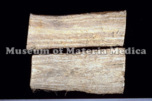Pueraria Root

|
Market name:板葛根 Photo location:Museum of Materia Medica, Inst. of Nat. Med. TMPW No.:9349 |

|
Plant name:Pueraria lobata Photo location:Gifu Pref., Japan Photo date:1987 Photographer:K. Komatsu |
| Synonym | |
| Latin name | Puerariae Radix |
| Botanical source: Family name | Leguminosae |
| Botanical source: Plant name | Pueraria lobata Ohwi (IPNI:214449-2) |
| Part used | Tuberous root |
| Empirical criteria for quality selection | Good one is powder white and rich in amyloid. Neither brown nor fibrous one is good. The one that is produced in China is rich in amyloid and the one in Japan is high in fiber (TN). |
| Constituents | Other aliphatic and related compounds: D-(+)-Pinitol Monosaccharides: D-Mannitol Polysaccharides: Starch Isoflavones: Daidzin, Daidzein, Daidzein 4',7-diglucoside, Puerarin, Puerarin-7-xyloside, 4',6''-O-Diacetylpuerarin, Genistein, Formononetin,Kakkonein, Puerarol, Miroestrol Simple nitrogen containing compounds: Allantoin |
| Pharmacological effects | Antipyretic, hyperglycemic (water extract). Spasmolytic (daidzein). |
| Indications | As a drug for diaphoresis, antifebrile and antispasmodic, it is applied to treat cough, fever, stiffness and pain of nape and back. |
| Diseases | Fever, Headache, stiffness in the back, Anhidrosis, Thirst, Muddy and watery stool, Diarrhea, Measles |
| Formulas | kakkon'oren'ogonto , kakkonkajutsubuto , kakkonkahangeto , kakkonkokato , kakkonto , kakkontokasenkyushin'i , keishikakakkonto , saikatsugekito , saikatsutokasenkyushin'i , shomakakkonto , jinsoin , zenshibyakujutsusan , dokkatsukakkonto , hontonto (kinkiyoryaku) , reitakutsukito , reitakutsukitokashin'i |
| Meridian tropism | Spleen, Stomach |
| Property | Neutral |
| Flavor | Sweet, Acrid/pungent |
| Classification in "Shen-non Ben-cao Jing" | Middle |
| TCM: Classification | Diaphoretics (Diaphoretics with cold propertiy) |
| TCM: Medicinal effects | To relieve fever, to promote the production of body fluid, to facilitate eruption, and to arrest diarrhea. Used for fever, headache and stiffness of the nape in exogenous affections, thirst, diabetes, measles with inadequate eruption, acute dysentery or diarrhea, stiff and painful nape in hypertension. |
| Remarks | Listed in the Japanese Pharmacopoeia 18th ed. In China, not only Pueraria thomsonii Benth. but also P. pseudo-hirsuta Tang et Wang may be found in the market. Taiwanese gegen is the root of P. montana (Lour.) Merrill. (JP: Taiwankuzu). The Japanese Kuzudenpun, which is made from Gegen, is important ingredient of Kuzuyu (soup of starch gegen). |
| References | TN: T. Namba & Y. Tsuda ed., Outline of Pharmacognosy, a Textbook, 3rd ed., Nankodo Co., Ltd., Tokyo, 1998. |
DNA sequences of medicinal plants
| Gene Region | |||||||||||||||||||
| Nuclear | Chloroplast | Mitochondria | |||||||||||||||||
| Botanical source: Plant name | 5Ss | 18S | ITS1 | 5.8S | ITS2 | 26S | others | trnH-psbA | matK | trnK | trnK-rps16 | trnT-L | trnL | trnL-F | rbcL | rpoC1 | ndhF | others | |
|
|
|||||||||||||||||||
|
|
|||||||||||||||||||
